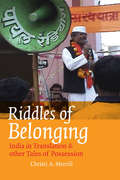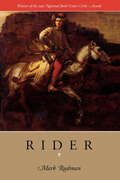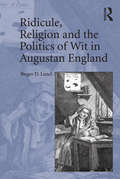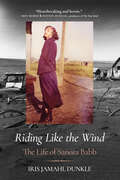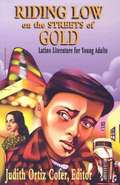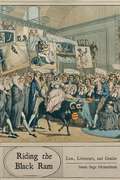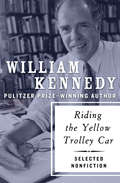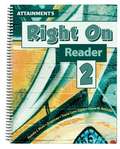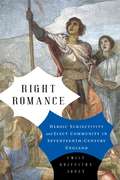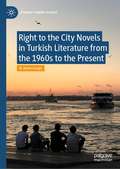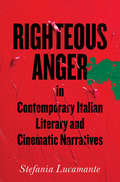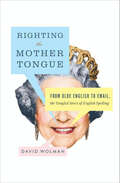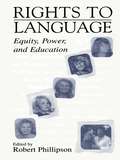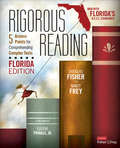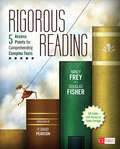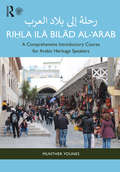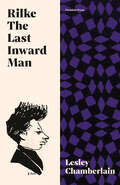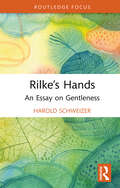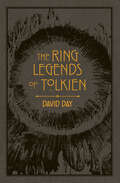- Table View
- List View
Riddles of Belonging: India in Translation and Other Tales of Possession
by Christi A. MerrillCan the subaltern joke? Christi A. Merrill answers by invoking riddling, oral-based fictions from Hindi, Rajasthani, Sanskrit, and Urdu that dare to laugh at what traditions often keep hidden-whether spouse abuse, ethnic violence, or the uncertain legacies of a divinely wrought sex change. Herself a skilled translator, Merrill uses these examples to investigate the expectation that translated work should allow the non-English-speaking subaltern to speak directly to the English-speaking reader. She plays with the trope of speaking to argue against treating a translated text as property, as a singular material object to be "carried across" (as trans-latus implies.) She refigures translation as a performative "telling in turn," from the Hindi word anuvad, to explain how a text might be multiply possessed. She thereby challenges the distinction between "original" and "derivative," fundamental to nationalist and literary discourse, humoring our melancholic fixation on what is lost. Instead, she offers strategies for playing along with the subversive wit found in translated texts. Sly jokes and spirited double entendres, she suggests, require equally spirited double hearings.The playful lessons offered by these narratives provide insight into the networks of transnational relations connecting us across a sea of differences. Generations of multilingual audiences in India have been navigating this "Ocean of the Stream of Stories" since before the 11th century, arriving at a fluid sense of commonality across languages. Salman Rushdie is not the first to pose crucial questions of belonging by telling a version of this narrative: the work of non-English-language writers like Vijay Dan Detha, whose tales are at the core of this book, asks what responsibilities we have to make the rights and wrongs of these fictions come alive "age after age."
Ride the Edge (Georgia)
by Isabel L. Beck Roger C. Farr Dorothy S. StricklandNIMAC-sourced textbook
Rider: The Rider Quintet, vol. 1 (Wesleyan Poetry Series)
by Mark RudmanRudman skillfully explores his own life and past.Winner of the National Book Critics Circle Award for Poetry (1995) Mark Rudman – poet, essayist, translator, and teacher – has consistently pursued questions of human relationship and identity, and in Rider he takes the poetry of autobiography and confessional to a new plane. In a polyphonic narrative that combines verse with lyrical prose and often humorous dialogue, Rudman examines his own coming-of-age through the lens of his relationships with his grandfather, father, step-father, and son. These memories emerge against the background of a family history anchored in the traditions of Judaism and the culture of the diaspora.
Ridicule, Religion and the Politics of Wit in Augustan England
by Roger D. LundArguing for the importance of wit beyond its use as a literary device, Roger D. Lund outlines the process by which writers in Restoration and eighteenth-century England struggled to define an appropriate role for wit in the public sphere. He traces its unpredictable effects in works of philosophy, religious pamphlets, and legal writing and examines what happens when literary wit is deliberately used to undermine the judgment of individuals and to destabilize established institutions of church and state. Beginning with a discussion of wit's association with deception, Lund suggests that suspicion of wit and the imagination emerges in attacks on the Restoration stage, in the persecution of The Craftsman, and in criticism directed at Thomas Hobbes's Leviathan and works by writers like the Earl of Shaftesbury, Thomas Woolston, and Thomas Paine. Anxieties about wit, Lund shows, were in part responsible for attempts to suppress new communal venues such as coffee houses and clubs and for the Church's condemnation of the seditious pamphlets made possible by the lapse of the Licensing Act in 1695. Finally, the establishment's conviction that wit, ridicule, satire, and innuendo are subversive rhetorical forms is glaringly at play in attempts to use libel trials to translate the fear of wit as a metaphorical transgression of public decorum into an actual violation of the civil code.
Riding Like the Wind: The Life of Sanora Babb
by Iris Jamahl DunkleThis saga of a writer done dirty resurrects the silenced voice of Sanora Babb, peerless author of midcentury American literature. In 1939, when John Steinbeck's The Grapes of Wrath was published, it became an instant bestseller and a prevailing narrative in the nation's collective imagination of the era. But it also stopped the publication of another important novel, silencing a gifted writer who was more intimately connected to the true experiences of Dust Bowl migrants. In Riding Like the Wind, renowned biographer Iris Jamahl Dunkle revives the groundbreaking voice of Sanora Babb. Dunkle follows Babb from her impoverished childhood in eastern Colorado to California. There, she befriended the era's literati, including Ray Bradbury and Ralph Ellison; entered into an illegal marriage; and was blacklisted by the House Un-American Activities Committee. It was Babb's field notes and oral histories of migrant farmworkers that Steinbeck relied on to write his novel. But this is not merely a saga of literary usurping; on her own merits, Babb's impact was profound. Her life and work feature heavily in Ken Burns's award-winning documentary The Dust Bowl and inspired Kristin Hannah in her bestseller The Four Winds. Riding Like the Wind reminds us with fresh awareness that the stories we know—and who tells them—can change the way we remember history.
Riding Low Through Streets of Gold: Latino Literature for Young Adults
by Judith Ortiz CoferThe pieces in this anthology for young adults reveal the struggles of discovering a new self and the trials of leaving behind an old one. This extraordinary collection gathers a wealth of stories and poems that explore the challenges of negotiating identity and relationships with others, struggling with authority, learning to love oneself and challenging the roles society demands of teenagers and adults. Edited by well-known poet and prose-writer Judith Ortiz Cofer, the collection includes work by such leading Latino writers as Pat Mora, Jesus Salvador Trevino, Tomas Rivera, Virgil Suarez, Jose Marti, Viramontes and Ortiz Cofer herself. Included as well are new voices that represent the freshness and vigor of youth: Mike Padilla, Daniel Chacon, and Sarah Cortez. For many students across the United States, this text will serve as their first rewarding introduction to diverse writers of Latino/Latina literature.
Riding the Black Ram
by Susan Sage HeinzelmanHeinzelman (English, U. of Texas at Austin) juxtaposes legal and literary narratives within their historical contexts in order to demonstrate how they are mutually constitutive and in order to reveal how both narrative approaches are articulated within a nomos, as understood in Robert M. Cover's 1983 essay "Foreword: Nomos and Narrative" as the overall normative universe. However, finding Cover's regulating nomos to exclude women's experiences and to privilege male kinship relationships, she coins the term nostos as a necessary supplement to nomos that articulates its gendered nature and, in contrast to nomos's production of narratives of regulation and equity, identifies and produces otherwise unarticulated and gendered narratives of desire. Chapters discuss the juxtaposition of the Chaucer's "Man of Law's Tale" with the "Wife of Bath's Tale, the juxtaposition of 17th and 18th-century romance novels by French and English women writers with juridical narratives, how the disciplinary and generic formation and policing of novelistic and legal discourses in the 17th and 18th centuries are disturbed and gendered by Mary Delarivier Manley's 1714 novel Rivella, the operation of discursive boundaries in three narratives of a 1752 trial of a woman for the murder of her father, and the gendered and sexualized tropes found in cultural representations of three queens (including a cartoon of Queen Caroline published during her 1820 trial for treasonous adultery that depicts the queen as riding a black ram into the House of Lords, which Heinzelman reads as a metaphor for women's disruptive presence). Annotation ©2010 Book News, Inc. , Portland, OR (booknews. com)
Riding the Yellow Trolley Car: Selected Nonfiction
by William KennedyThe collected nonfiction of the Pulitzer Prize–winning author of Ironweed: &“A great pleasure to read no matter what the subject&” (Library Journal). When William Kennedy arrives in Barcelona, his guidebook recommends taking the trolley around town—but the trolleys haven&’t run in the city for years. He&’s on his way to interview the novelist Gabriel García Márquez when, out of the corner of his eye, he sees something impossible: a yellow trolley running down the street. Márquez, however, is not surprised; like all great writers of both fiction and nonfiction, he knows that impossible things happen every day. A remarkable collection from one of America&’s greatest authors, Riding the Yellow Trolley Car features work from all stages of Kennedy&’s career. Through each piece runs the thread that ties together his greatest works: a love and deep understanding of his hometown, the city of Albany, New York, and the good and evil men who have made it what it is. Featuring interviews and essays on some of the most prominent authors of the twentieth century, from Saul Bellow and E. L. Doctorow to Norman Mailer and the legendary García Márquez—as well as insightful reflections on topics from baseball to the death of a prominent cat to Kennedy&’s wife&’s hiccups—Riding the Yellow Trolley Car is an essential book for all those who love to read, or live to write.
Right On Reader 2
by Diane M. Browder Pamela J. Mims Angel Lee Tracie-Lynn Zakas Jo Reynolds Beverly Potts Linda R. SchreiberA systematic language arts curriculum for middle and high school studentsResearch has shown Teaching to Standards: English Language Arts to be highly effective in teaching skills that align to grade-level standards.
Right Romance: Heroic Subjectivity and Elect Community in Seventeenth-Century England (Cultural Inquiries in English Literature, 1400–1700 #1)
by Emily Griffiths JonesIn this book, Emily Griffiths Jones examines the intersections of romance, religion, and politics in England between 1588 and 1688 to show how writers during this politically turbulent time used the genre of romance to construct diverse ideological communities for themselves.Right Romance argues for a recontextualized understanding of romance as a multigeneric narrative structure or strategy rather than a prose genre and rejects the common assumption that romance was a short-lived mode most commonly associated with royalist politics. Puritan republicans likewise found in romance strength, solace, and grounds for political resistance. Two key works that profoundly influenced seventeenth-century approaches to romance are Philip Sidney’s New Arcadia and Edmund Spenser’s The Faerie Queene, which grappled with romance’s civic potential and its limits for a newly Protestant state. Jones examines how these works influenced writings by royalists and republicans during and after the English Civil War. Remaining chapters pair writers from both sides of the war in order to illuminate the ongoing ideological struggles over romance. John Milton is analyzed alongside Margaret Cavendish and Percy Herbert, and Lucy Hutchinson alongside John Dryden. In the final chapter, Jones studies texts by John Bunyan and Aphra Behn that are known for their resistance to generic categorization in an attempt to rethink romance’s relationship to election, community, gender, and generic form.Original and persuasive, Right Romance advances theoretical discussion about romance, pushing beyond the limits of the genre to discover its impact on constructions of national, communal, and personal identity.
Right Romance: Heroic Subjectivity and Elect Community in Seventeenth-Century England (Cultural Inquiries in English Literature, 1400–1700)
by Emily Griffiths JonesIn this book, Emily Griffiths Jones examines the intersections of romance, religion, and politics in England between 1588 and 1688 to show how writers during this politically turbulent time used the genre of romance to construct diverse ideological communities for themselves.Right Romance argues for a recontextualized understanding of romance as a multigeneric narrative structure or strategy rather than a prose genre and rejects the common assumption that romance was a short-lived mode most commonly associated with royalist politics. Puritan republicans likewise found in romance strength, solace, and grounds for political resistance. Two key works that profoundly influenced seventeenth-century approaches to romance are Philip Sidney’s New Arcadia and Edmund Spenser’s The Faerie Queene, which grappled with romance’s civic potential and its limits for a newly Protestant state. Jones examines how these works influenced writings by royalists and republicans during and after the English Civil War. Remaining chapters pair writers from both sides of the war in order to illuminate the ongoing ideological struggles over romance. John Milton is analyzed alongside Margaret Cavendish and Percy Herbert, and Lucy Hutchinson alongside John Dryden. In the final chapter, Jones studies texts by John Bunyan and Aphra Behn that are known for their resistance to generic categorization in an attempt to rethink romance’s relationship to election, community, gender, and generic form.Original and persuasive, Right Romance advances theoretical discussion about romance, pushing beyond the limits of the genre to discover its impact on constructions of national, communal, and personal identity.
Right to the City Novels in Turkish Literature from the 1960s to the Present (Literary Urban Studies)
by N. Buket CengizRight to the City Novels in Turkish Literature from the 1960s to the Present analyses the representation of rural migration to Istanbul in literature, placing Henri Lefebvre’s concept of the right to the city at the centre of the argument. Using a framework of critical urban theory, the book examines Orhan Kemal’s Gurbet Kuşları [The Homesick Birds] (1962); Muzaffer İzgü’s Halo Dayı ve İki Öküz [Uncle Halo and Two Oxen] (1973); Latife Tekin’s Berci Kristin Çöp Masalları [Berji Kristin: Tales From the Garbage Hills] (1984); Metin Kaçan’s Ağır Roman [Heavy Roman(i)] (1990); Ayhan Geçgin’s Kenarda [On the Periphery] (2003); Hatice Meryem’s İnsan Kısım Kısım, Yer Damar Damar [It Takes All Kinds] (2008); and Orhan Pamuk’s Kafamda Bir Tuhaflık [A Strangeness in My Mind] (2014) in the historical context as regards rural migration to Istanbul, urbanization of migrants, and anti-migrant nostalgia. Situating these works as a counterpoint to nostalgic novels and categorising them as right to the city novels, the book aims to offer a conceptual framework that can be implemented on internal as well as international migration in other global(ising) cities; and on cultural products other than literature, such as film.
Righteous Anger in Contemporary Italian Literary and Cinematic Narratives (Toronto Italian Studies)
by Stefania LucamanteRighteous Anger in Contemporary Italian Literary and Cinematic Narratives analyses the role of passion— particularly indignation—and how it shapes intention and inspires the work of many contemporary Italian writers and filmmakers. Noting how art often holds the power to shed light on issues surrounding inequity, inequality, and injustice, the book explores the ethical function of art as a tool in resistance and sociopolitical protest, thereby validating the axiom that ethics and aesthetics can still collaborate in the creation of meaning. Drawing on a range of Italian novels and films and examining the works of artists such as Tiziano Scarpa, Simona Vinci, Paolo Sorrentino, and Monica Stambrini, the author shows that anger can be used constructively as a weapon of resistance against negative and oppressive forces.
Righting the Mother Tongue: From Olde English to Email, the Tangled Story of English Spelling
by David Wolman“A funny and fact-filled look at our astoundingly inconsistent written language, from Shakespeare to spell-check.” —St. Petersburg TimesRighting the Mother Tongue tells the cockamamie story of English spelling. When did ghost acquire its silent ‘h’? Will cyberspace kill the one in rhubarb? And was it really rocket scientists who invented spell-check?Seeking to untangle the twisted story of English spelling, David Wolman takes us on a wordly adventure from English battlefields to Google headquarters. Along the way, he pickets with spelling reformers outside the national spelling bee, visits the town in Belgium, not England, where the first English books were printed, and takes a road trip with the boss at Merriam-Webster Inc. The journey is punctuated by spelling battles waged by the likes of Samuel Johnson, Noah Webster, Theodore Roosevelt, Andrew Carnegie, and the members of today’s Simplified Spelling Society.Rich with history, pop culture, curiosity, and humor, Righting the Mother Tongue explores how English spelling came to be, traces efforts to mend the code, and imagines the shape of tomorrow’s words.“Lively, informative . . . prov[es] that the English spelling system is a hopeless tangle of French, Dutch, Latin, German and much, much more and really makes no sense at all.” —Portland Tribune“An engaging ramble through our orthographic thickets.” —The Boston Globe“Sprightly history that sensibly balances the merits of standardization against the forces for freedom.” —Kirkus Reviews
Rights to Language: Equity, Power, and Education
by Robert PhillipsonRights to Language: Equity, Power, and Education brings together cutting-edge scholarship in language, education, and society from all parts of the world. Celebrating the 60th birthday of Tove Skutnabb-Kangas, it is inspired by her work in minority, indigenous, and immigrant education; multilingualism; linguistic human rights; and global language and power issues. Rights to Language situates issues of minorities and bilingual education in broader perspectives of human rights, power, and the ecology of language. The rich mix of papers serves to underline that the issues are comparable worldwide, that many disparate topics can cross-fertilize each other, and that our understanding of the issues can benefit from coverage that is global, reflective, and committed. A Web site with additional resource materials to this book can be found on http://www.cbs.dk/staff/phillipson/
Rigorous Reading, Florida Edition: 5 Access Points for Comprehending Complex Texts (Corwin Literacy)
by Douglas Fisher Nancy FreyNewly revised and updated throughout, this new Florida Edition has been specially developed to align with Florida’s new B.E.S.T. Standards. What it really means to "read closely." What could Fern Arable, Jay Gatsby, and Winston Churchill possibly have in common? They all need masterful teachers to help students revel in their complexity. And Nancy Frey and Doug Fisher are just the two mentors to help you make that happen. Call it close reading, call it deep reading, call it analytic reading—call it what you like. The point is, it′s a level of understanding that students of any age can achieve with the right kind of instruction. In Rigorous Reading, Nancy and Doug articulate an instructional plan so clearly, and so squarely built on research, that teachers, schools, and districts need look no further. The 5 Access Points Toward Proficiency, Purpose & Modeling: Teachers think aloud to demonstrate critical thinking and how good readers always know why they are reading. Close & Scaffolded Reading Instruction: Teachers engage students in repeated readings and discussions, with text-dependent questions, prompts, and cues to help students delve into an author′s ideas. Collaborative Conversations: Teachers orchestrate collaborative learning to get students in the habit of exercising their analytical thinking in the presence of their peers. An Independent Reading Staircase: Teachers artfully steer students to more challenging books, with strategic bursts of instruction and peer conferences to foster metacognitive awareness. Performance: Teachers offer feedback and assessments that help students demonstrate understanding of text in authentic ways and plan instruction based on student understanding. There′s more . . . Also included are illustrative classroom video clips available via QR codes—making Rigorous Reading the only resource a teacher, school, or district needs to seriously stretch students′ capacity to read and comprehend text.
Rigorous Reading, Florida Edition: 5 Access Points for Comprehending Complex Texts (Corwin Literacy)
by Douglas Fisher Nancy FreyNewly revised and updated throughout, this new Florida Edition has been specially developed to align with Florida’s new B.E.S.T. Standards. What it really means to "read closely." What could Fern Arable, Jay Gatsby, and Winston Churchill possibly have in common? They all need masterful teachers to help students revel in their complexity. And Nancy Frey and Doug Fisher are just the two mentors to help you make that happen. Call it close reading, call it deep reading, call it analytic reading—call it what you like. The point is, it′s a level of understanding that students of any age can achieve with the right kind of instruction. In Rigorous Reading, Nancy and Doug articulate an instructional plan so clearly, and so squarely built on research, that teachers, schools, and districts need look no further. The 5 Access Points Toward Proficiency, Purpose & Modeling: Teachers think aloud to demonstrate critical thinking and how good readers always know why they are reading. Close & Scaffolded Reading Instruction: Teachers engage students in repeated readings and discussions, with text-dependent questions, prompts, and cues to help students delve into an author′s ideas. Collaborative Conversations: Teachers orchestrate collaborative learning to get students in the habit of exercising their analytical thinking in the presence of their peers. An Independent Reading Staircase: Teachers artfully steer students to more challenging books, with strategic bursts of instruction and peer conferences to foster metacognitive awareness. Performance: Teachers offer feedback and assessments that help students demonstrate understanding of text in authentic ways and plan instruction based on student understanding. There′s more . . . Also included are illustrative classroom video clips available via QR codes—making Rigorous Reading the only resource a teacher, school, or district needs to seriously stretch students′ capacity to read and comprehend text.
Rigorous Reading: 5 Access Points for Comprehending Complex Texts
by Douglas B. Fisher Dr Nancy FreyWhat it really means to “read closely” Call it close reading, call it deep reading, call it analytic reading—call it what you like. The point is, it’s a level of understanding that students of any age can achieve with the right kind of instruction. In Rigorous Reading, Nancy Frey and Doug Fisher articulate an instructional plan so clearly, and so squarely built on research, that teachers, schools, and districts need look no further: Purpose & Modeling Close & Scaffolded Reading Instruction Collaborative Conversations An Independent Reading Staircase Performance
Riḥla ilā Bilād al-‘Arab رحلة إلى بلاد العرب: A Comprehensive Introductory Course for Arabic Heritage Speakers
by Munther YounesRiḥla ilā Bilād al-‘Arab starts with the Arabic alphabet and gradually and systematically builds the reading and writing skills and mastery of Fuṣḥā grammar. As students develop their reading, writing, and grammar skills, they will be learning about Arab history, society, and culture. This book contextualizes Arabic grammar teaching with sufficient and relevant drills and exercises. Added personal and cultural interest is given by the diary of Amal, an American student of Arab descent, who travels to Jordan and Palestine. This textbook includes maps, illustrations, and photographs and is accompanied by audio on the companion website that can be viewed here: www.routledge.com/cw/younes . The book is designed for Arabic heritage students—students who can understand and speak an Arabic dialect (Egyptian, Iraqi, Moroccan, etc.) but are unfamiliar with Modern Standard Arabic, known as Fuṣḥā.
Rilke: The Last Inward Man
by Lesley ChamberlainAn incisive and intimate account of the life and work of the great poet Rilke, exploring the rich interior world he created in his poetryWhen Rilke died in 1926, his reputation as a great poet seemed secure. But as the tide of the critical avant-garde turned, he was increasingly dismissed as apolitical, as too inward. In Rilke: The Last Inward Man, acclaimed critic Lesley Chamberlain uses this charge as the starting point from which to explore the expansiveness of the inner world Rilke created in his poetry. Weaving together searching insights on Rilke's life, work and reception, Chamberlain casts Rilke's inwardness as a profound response to a world that seemed ever more lacking in spirituality. In works of dazzling imagination and rich imagery, Rilke sought to restore spirit to Western materialism, encouraging not narrow introversion but a heightened awareness of how to live with the world as it is, of how to retain a sense of transcendence within a world of collapsed spiritual certainty.
Rilke’s Hands: An Essay on Gentleness (Routledge Focus on Literature)
by Harold SchweizerThis is a book of meditative reading. Each of the sixty-one aphoristic entries aims to interpret Rilke’s poetry as a musician might play Debussy’s Clair de lune, to transpose into the key of language the song, the melody, and the refrain of Rilke’s gentle disposition: his recognition of the transience of things; his acknowledgment of the vulnerability and fragility of people, animals, and flowers; his empathy toward those who suffer. The cut flowers gently laid out on the garden table "recovering from their death already begun" in one of theSonnets to Orpheus form a thread now visible now faint through most of this book. And because of the flowers, the concept of gentleness forms another thread, and because of gentleness, hands—agents of gentleness throughout Rilke’s poetry—enfold these pages. The German word leise (gentle, tender, quiet) weaves the first thread; the second is woven by flowers, then by girls’ hands, then by angels, the beloved, the poor, the dying and the dead, animals, birds, dogs, fountains, things, vanishings. The purpose of this essay is to experience and to examine gentleness, how it shapes and pervades Rilke’s work, how his poetry might gently inspire us to become more gentle people.
Rimjhim class 3 - NCERT - 23: रिमझिम ३री कक्षा - एनसीईआरटी - २३
by Rashtriy Shaikshik Anusandhan Aur Prashikshan Parishadराष्ट्रीय पाठ्यचर्या की रूपरेखा (2005) सुझाती है कि बच्चों के स्कूली जीवन को बाहर के जीवन से जोड़ा जाना चाहिए। यह सिद्धांत किताबी ज्ञान की उस विरासत के विपरीत है जिसके प्रभाववश हमारी व्यवस्था आज तक स्कूल और घर के बीच अंतराल बनाए हुए है। नई राष्ट्रीय पाठ्यचर्या पर आधारित पाठ्यक्रम और पाठ्यपुस्तकें इस बुनियादी विचार पर अमल करने का प्रयास है। बच्चों के हाथ में जैसे ही कोई नई किताब आती है, वे झट से उसे उलटना-पलटना शुरू कर देते हैं। उनमें एक स्वाभाविक उतावलापन होता है- चित्र निहारने का, कविता और कहानियों के बारे में जानने का या स्वयं उन्हें पढ़ डालने का। इस पाठ्यपुस्तक ने उनकी इस स्वाभाविक प्रवृत्ति का भरपूर फ़ायदा उठाने की कोशिश की है। किताब के लिए ऐसी कविताओं और कहानियों को चुना गया है, जिनमें बच्चों की बातचीत, उनकी आदतें, उनके नखरे, जिद, उनके सवाल साफ़-साफ़ झलकते हैं। इसलिए बच्चे ऐसी कविताओं या कहानियों से विचार और भावनाओं के स्तर पर एक जुड़ाव महसूस करेंगे।
Rimjhim class 4 - NCERT - 23: रिमझिम ४थीं कक्षा - एनसीईआरटी - २३
by Rashtriy Shaikshik Anusandhan Aur Prashikshan Parishadराष्ट्रीय पाठ्यचर्या की रूपरेखा-2005 सभी मूल्यों की जड़ में सामाजिक सद्भाव एवं शांति को चिह्नित करती है और इस उद्देश्य के लिए प्रत्येक विषय को महत्त्व देती है। शांतिपरक मूल्यों के विकास में भाषा की भूमिका सर्वाधिक महत्त्वपूर्ण है। भाषा किसी भी संस्कृति में मूल्यों को बनाए रखने का काम करती है। दूसरों के प्रति खासकर असमानता, क्षमता या पृष्ठभूमि के अंतर के संदर्भ में बच्चों को संवेदनशील बनाना भी भाषा-शिक्षण के दौरान होना चाहिए। इसी बात को ध्यान में रखते हुए पुस्तक में सुनीता की पहिया कुर्सी पाठ दिया गया है। इसी तरह की अन्य सामग्री पत्र-पत्रिकाओं से या स्वयं विकसित करके शिक्षक उनका उपयोग कर सकते हैं। शिक्षक को चाहिए कि मूल्यों के विकास में भाषा की भूमिका सुनिश्चित करते हुए कक्षा में अपने और बच्चों के व्यवहार में उसकी परिणति लाए। रिमझिम 4 में भी कई पाठ सिर्फ़ पढ़ने के लिए दिए गए हैं उनके साथ कोई प्रश्न नहीं है। इन पाठों को देने का उद्देश्य बच्चों को पढ़ने की अतिरिक्त सामग्री उपलब्ध कराना है जिसे वे प्रश्नों के बोझ से मुक्त होकर आनंद लेते हुए पढ़ सकें। बच्चों को पढ़ने के जितने अधिक अवसर मिलेंगे, उतना ही अधिक उनकी पढ़ने की गति एवं शब्द-भंडार बढ़ेगा तथा वर्तनी संबंधी त्रुटियों में कमी आएगी।
Rimjhim class 5 - NCERT - 23: रिमझिम ५वीं कक्षा - एनसीईआरटी - २३
by Rashtriy Shaikshik Anusandhan Aur Prashikshan Parishadइस रिमझिम पुस्तक में ताने-बाने को चार सूत्रों में पिरोया गया है। हर सूत्र का अपना रंग और अपनी छटा है। अपनी-अपनी रंगतें के अंतर्गत रीति-रिवाज़, जीवन शैली, हुनर, विरासत और बोली आदि संस्कृति के विभिन्न आयामों की झलक है। इस भाग को पढ़ाते समय यह ध्यान में रखना ज़रूरी होगा कि सांस्कृतिक विविधता के बारे में शिक्षक का स्वयं का ज्ञान ही इन पाठों को बच्चे के लिए जीवंत बना सकता है। इस भाग के माध्यम से रिमझिम-5 हमारी अनमोल विरासत को सहेजने का प्रयास है। अभिव्यक्ति के कई माध्यम हैं। समय के साथ-साथ इन माध्यमों में भी बदलाव आया है। अपनी बात लोगों तक पहुँचाने का तरीका समय के साथ कैसे बदलता रहा है- पुस्तक के दूसरे भाग बात का सफ़र में इसी रोचक सफ़र की झलक है। रिमझिम-5 में कई साहित्यकारों की रचनाएँ ली गई हैं। जैसे- प्रेमचंद, सुभद्रा कुमारी चौहान, नागार्जुन, सोहनलाल द्विवेदी, आर. के. नारायण आदि। आने वाली कक्षाओं में साहित्य से बच्चों का परिचय उत्तरोत्तर बढ़ता जाएगा। रचनाओं को गहराई से समझने के लिए उनके लेखकों का परिचय उपयोगी है।
Ring Legends of Tolkien (Tolkien Illustrated Guides #7)
by David DayLearn the most popular legends about the Rings of Power!The history of J. R. R. Tolkien's fictional world of Middle-earth is filled with an ongoing struggle between good and evil, centered on a set of rings forged by Elves and an evil sorcerer. The Ring Legends of Tolkien recounts stories and conflicts surrounding the Rings of Power. Insightful commentary by Tolkien scholar David Day discusses how people, tactics, and weapons were used to obtain and control the rings, and also how the legends of Middle-earth relate to the real-world mythology on which Tolkien based his famous literary creation. Maps and full-color illustrations help bring this rich universe to life, making it an invaluable reference book for Tolkien fans of all ages. This work is unofficial and is not authorized by the Tolkien Estate or HarperCollins Publishers.
